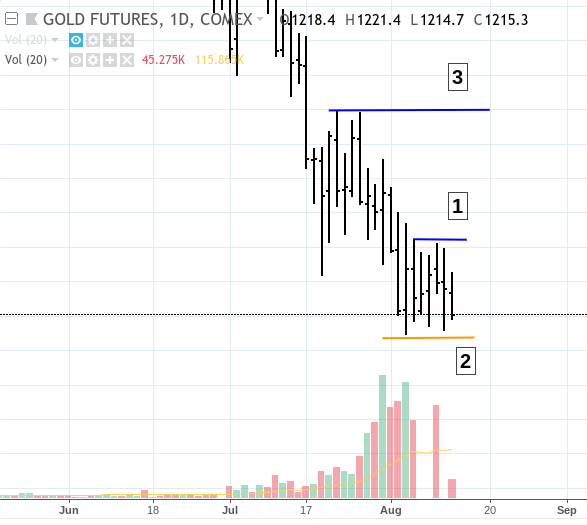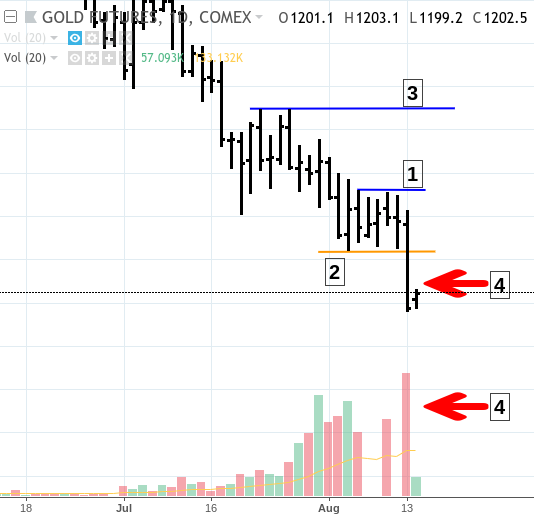A contrarian view to gold’s decline
Spot gold has declined overall since the beginning of the year. Compared to how investors may typically define a “stock” bear market, which is a drop of 20% of more, gold’s drop might still be considered well within correction territory.
A gold correction or a bear?
This is typically where you have to assess fundamentals to determine whether sentiment deviates from sound economics. And right now, it seems that gold’s safe haven status being falling out of favor, with the dollar rising and the stock market looking to make more highs.
Yet with the national debt growing and the uncertainty of the hostile trade environment in which the US is currently engaged, it seems as if the notion of a safe haven might make economic sense. Plus, gold’s seasonal factors have seen many instances (not all instances, of course) in which the yellow metal had risen significantly in August.
Trading an Anticipated Contrarian Bounce in December Gold
Here’s how the situation looked on August 12, 2018. A contrarian swing trade may have seemed like a dangerous thing to attempt given that the potential for downside seems much more probable than an upside swing. But again, trends, from minor to major ones, are known to have their reactions (corrections), as prices hardly ever move in a straight line.
So if you were to have taken a contrarian trade, what’s one possible setup that might have allowed you a short-term upside target with relatively small risk (emphasis on “relatively”)?
GCZ18 Daily Chart from July 2 to August 12, 2018

Gold looked like it might have been in an early stage of consolidation, given the two levels of resistance (1) at 1225.00 and two levels of support (2) near 1211.00. If price were to break toward the upside, even if such a break were to be a mere reaction to the current downward trend, then price would have to break the upper end of this consolidation range.
An aggressive approach to a contrarian swing trade would be to place a buy stop a tick or two above 1225.00. Had price broken above the 1225.00 range at relatively higher volume, then such a trade might have been considered more favorable, as higher volume might have indicated the possibility of greater buying pressure leading to a follow-through in the direction of the breakout.
Assuming that such a breakout might follow through, 1245.00 as shown at point (3) would have been the swing target, assuming that price would also have moved past 1237.00, a minor resistance point.
But this breakout did not happen, as price broke below support (4) on the following day with high volume (4).

Jumping the gun on this trade would have resulted in a loss
Not all swing traders trade upon a breakout. And not all breakouts result in a favorable move. But trading a technical breakout can at least reveal two factors that may be critical in determining the favorability in a trade: first, that a breakout above resistance had occurred with high volume (indicating buying pressure) and that a follow-through might confirm the favorability of your directional bias.
As you can see, these two factors did occur, but for traders on the short side. As for traders with a contrarian long bias who placed their entry orders above the breakout level, the market action would have resulted in no trade, which might have been more favorable than a loss. In short, they would have dodged a bullet.
Again, not every swing trader will want to trade a breakout; and not every breakout will succeed. But any price movements supported by indications of a larger number of buyers and sellers may be more favorable than movements that show little support. And getting into a trade too soon may rob you the chance of seeing these technical indications that may be important for such technically-based trades.
Please be aware that the content of this blog is based upon the opinions and research of GFF Brokers and its staff and should not be treated as trade recommendations. There is a substantial risk of loss in trading futures, options and forex. Past performance is not necessarily indicative of future results.
Disclaimer Regarding Hypothetical Performance Results: HYPOTHETICAL PERFORMANCE RESULTS HAVE MANY INHERENT LIMITATIONS, SOME OF WHICH ARE DESCRIBED BELOW. NO REPRESENTATION IS BEING MADE THAT ANY ACCOUNT WILL OR IS LIKELY TO ACHIEVE PROFITS OR LOSSES SIMILAR TO THOSE SHOWN. IN FACT, THERE ARE FREQUENTLY SHARP DIFFERENCES BETWEEN HYPOTHETICAL PERFORMANCE RESULTS AND THE ACTUAL RESULTS SUBSEQUENTLY ACHIEVED BY ANY PARTICULAR TRADING PROGRAM.
ONE OF THE LIMITATIONS OF HYPOTHETICAL PERFORMANCE RESULTS IS THAT THEY ARE GENERALLY PREPARED WITH THE BENEFIT OF HINDSIGHT. IN ADDITION, HYPOTHETICAL TRADING DOES NOT INVOLVE FINANCIAL RISK, AND NO HYPOTHETICAL TRADING RECORD CAN COMPLETELY ACCOUNT FOR THE IMPACT OF FINANCIAL RISK IN ACTUAL TRADING. FOR EXAMPLE, THE ABILITY TO WITHSTAND LOSSES OR TO ADHERE TO A PARTICULAR TRADING PROGRAM IN SPITE OF TRADING LOSSES ARE MATERIAL POINTS WHICH CAN ALSO ADVERSELY AFFECT ACTUAL TRADING RESULTS. THERE ARE NUMEROUS OTHER FACTORS RELATED TO THE MARKETS IN GENERAL OR TO THE IMPLEMENTATION OF ANY SPECIFIC TRADING PROGRAM WHICH CANNOT BE FULLY ACCOUNTED FOR IN THE PREPARATION OF HYPOTHETICAL PERFORMANCE RESULTS AND ALL OF WHICH CAN ADVERSELY AFFECT ACTUAL TRADING RESULTS.